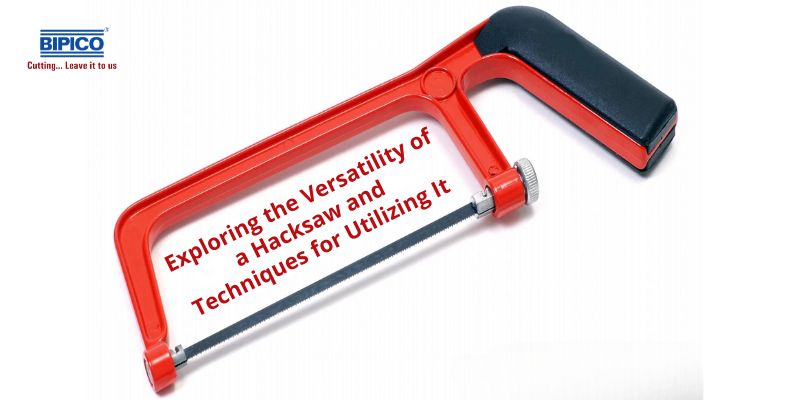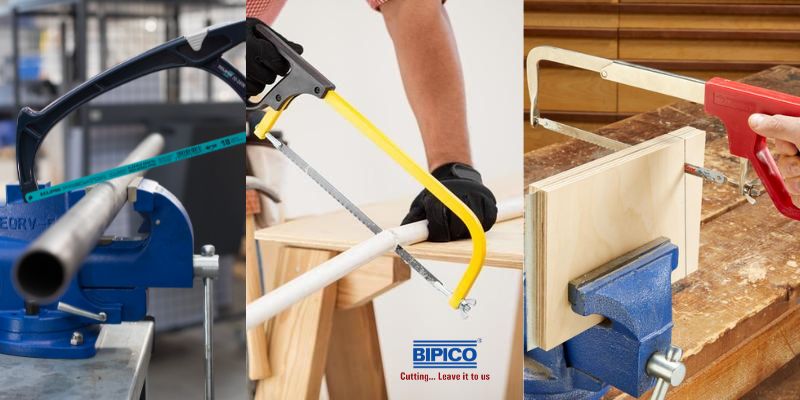Exploring the Versatility of a Hacksaw and Techniques for Utilizing It
In the world of hand tools, the hacksaw is a versatile and indispensable tool that finds its application in various industries and DIY projects. Its ability to cut through a wide range of materials makes it a must-have for any toolbox. In this blog, we will delve into the various applications of a hacksaw and provide you with techniques to maximize its potential.
I. Understanding the Anatomy of a Hacksaw
Before we delve into the techniques, it is essential to familiarise ourselves with the basic components of a hacksaw:
Frame: The frame is the main body of the hacksaw, typically made of metal, and provides the structure and support for the blade.
Blade: The blade is the cutting component of the hacksaw, usually detachable for easy replacement. It comes in various tooth configurations designed for specific materials.
Tensioning Mechanism: This mechanism allows you to adjust the blade's tension, ensuring it stays taut and straight during use.
Handle: The handle provides a comfortable grip for the user, allowing precise control and reducing fatigue during prolonged use.
II. Materials Suitable for Hacksaw Cutting
Hacksaws are incredibly versatile and can cut a wide range of materials. Some of the most common materials include:
Metal: Hacksaws are highly effective in cutting various metals, including steel, aluminium, brass, and copper.
Plastic: With the right blade, hacksaws can make clean cuts in plastics like PVC, ABS, and acrylic.
Wood: While not the primary use, hacksaws equipped with a fine-toothed blade can cut small wooden pieces.
Fibreglass: Hacksaws can also cut fibreglass, making them useful in applications like boat repair.
III. Techniques for Maximizing Hacksaw Efficiency
Selecting the Right Blade: The choice of blade is crucial for achieving clean and efficient cuts. Consider the following factors when selecting a blade:
Teeth Per Inch (TPI): Higher TPI blades are suitable for finer, more delicate materials, while lower TPI blades are better for thicker and harder materials.
Material Compatibility: Ensure the blade is designed for the specific material you intend to cut. For example, blades are designed for metals, plastics, and wood.
Setting the Blade Tension: Proper tensioning of the blade ensures it remains straight and minimizes the risk of bending or breaking. Use the tensioning mechanism on the hacksaw frame to achieve the right level of tension.
Marking and Clamping: Before cutting, it is essential to mark the material accurately. Use a measuring tool and a marker to create a clear guideline. Additionally, secure the material in place using clamps or a vice to prevent any movement during cutting.
Applying Even Pressure: Apply consistent and even pressure while sawing. Avoid using excessive force, which can lead to blade bending or breakage. Let the teeth of the blade do the work, allowing for a smooth and controlled cut.
Using Lubrication (for Metal Cutting): When cutting metals, significantly harder ones like steel, consider using a lubricant to reduce friction and heat buildup. This prolongs the life of the blade and results in a cleaner cut.
Practice Safety Measures: Always wear safety goggles and gloves when using a hacksaw. This protects your eyes from debris and your hands from potential cuts. Additionally, be aware of your surroundings and maintain proper posture to avoid strain.
IV. Specialized Techniques for Hacksaw Cutting
Angle Cutting: Hacksaws can make precise angled cuts by tilting the blade slightly while maintaining a steady hand. This technique is beneficial for tasks that require bevelled edges or custom angles.
Curved Cuts: While a hacksaw is primarily a straight-cutting tool, with some practice, it can also be used to make gentle curves in thinner materials. Start by making relief cuts at intervals along the curve, then carefully guide the saw along the desired path.
Notching: Hacksaws excel at creating notches or slots in materials. This technique is commonly used in carpentry and metalworking to create joints or fittings in structural elements.
V. Maintaining Your Hacksaw
Blade Replacement: Regularly inspect the condition of the blade. If you notice any dullness, damage, or missing teeth, it is time to replace them. A sharp blade ensures efficient cutting and minimizes the risk of accidents.
Cleaning: After use, clean any debris or residue from the blade and frame to prevent corrosion and maintain its longevity. Use a wire brush or a cloth to remove stubborn material buildup.
Lubrication (for Metal Cutting): Apply a light coating of cutting oil or a specialized lubricant to the blade when cutting metals. This helps reduce friction and prolongs the life of the blade.
Storage: Store your hacksaw in a dry, cool place away from direct sunlight. Keep it in a case or wrap it in a cloth to protect it from dust and moisture.
Conclusion
The hacksaw is a versatile tool that proves its worth in many applications. By understanding its anatomy, knowing which materials it can cut, and employing the proper techniques, you can make the most of this indispensable tool. Whether you are a seasoned professional or a DIY enthusiast, having a hacksaw in your toolkit opens up a world of possibilities for precision cutting and fabrication. So embrace the hacksaw and let your creativity flow!






Comments
Post a Comment